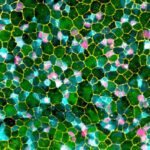Lien vers Pubmed [PMID] – 21205785
Development 2011 Feb;138(3):397-408
Proper spatial control of neurogenesis in the inner ear ensures the precise innervation of mechanotransducing cells and the propagation of auditory and equilibrium stimuli to the brain. Members of the Hairy and enhancer of split (Hes) gene family regulate neurogenesis by inhibiting neuronal differentiation and maintaining neural stem cell pools in non-neurogenic zones. Remarkably, their role in the spatial control of neurogenesis in the ear is unknown. In this study, we identify her9, a zebrafish ortholog of Hes1, as a key gene in regulating otic neurogenesis through the definition of the posterolateral non-neurogenic field. First, her9 emerges as a novel otic patterning gene that represses proneural function and regulates the extent of the neurogenic domain. Second, we place Her9 downstream of Tbx1, linking these two families of transcription factors for the first time in the inner ear and suggesting that the reported role of Tbx1 in repressing neurogenesis is in part mediated by the bHLH transcriptional repressor Her9. Third, we have identified retinoic acid (RA) signaling as the upstream patterning signal of otic posterolateral genes such as tbx1 and her9. Finally, we show that at the level of the cranial otic field, opposing RA and Hedgehog signaling position the boundary between the neurogenic and non-neurogenic compartments. These findings permit modeling of the complex genetic cascade that underlies neural patterning of the otic vesicle.
